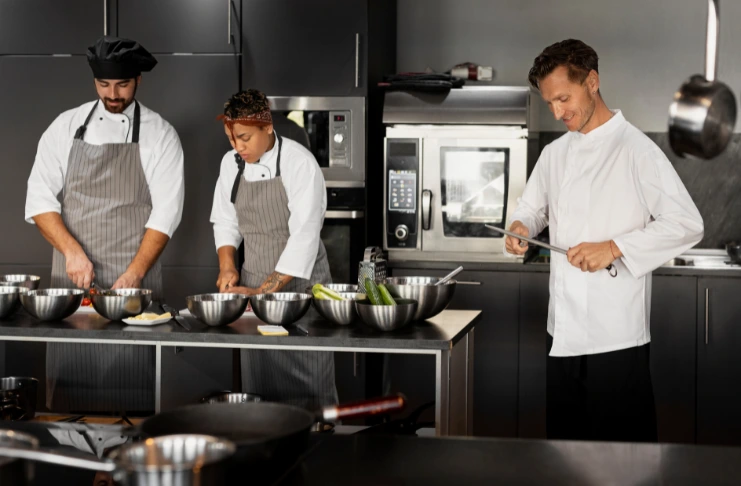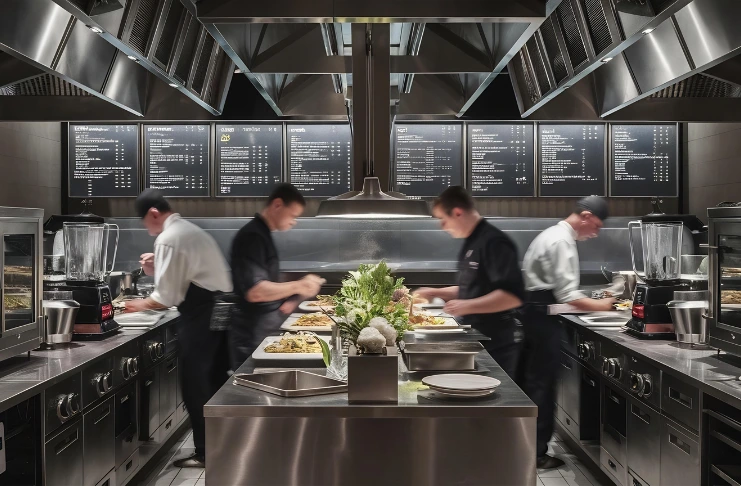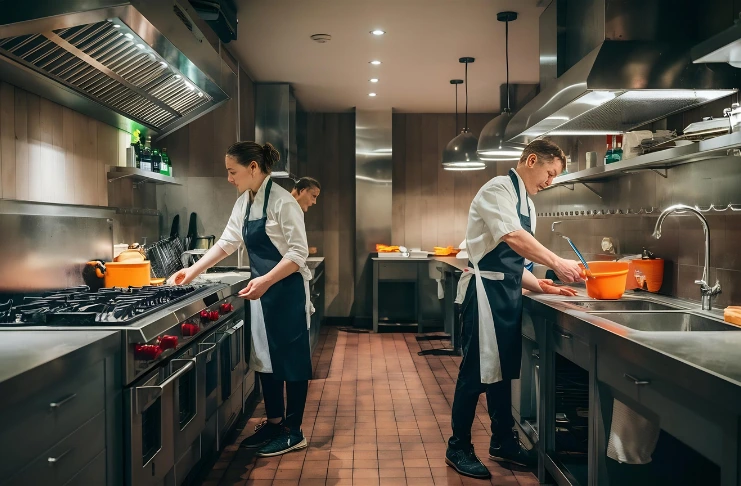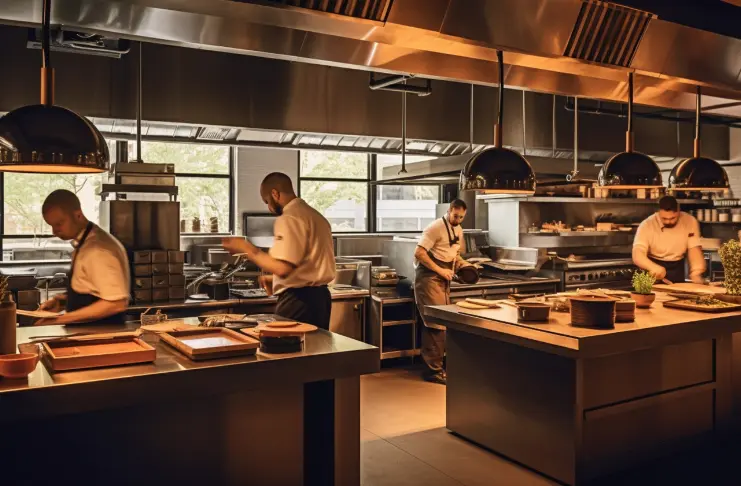The food service industry is rapidly evolving, with shared kitchen spaces for cloud kitchens revolutionizing how restaurants operate, especially with the rise of delivery apps. These fully equipped commercial kitchens allow multiple food businesses to rent space, reducing overhead costs and enabling virtual restaurants to thrive.
Driven by rising food delivery demand and shifting consumer habits, shared commercial kitchens offer flexible, affordable solutions that support virtual restaurants with professional-grade equipment. It eliminates the need for expensive brick-and-mortar setups and offers affordable commercial kitchen space, lowering barriers for both startups and established brands.
The cloud kitchen business model has transformed from a niche idea into a mainstream strategy, reshaping food delivery services and empowering entrepreneurs to scale quickly. As this trend grows, understanding the benefits of shared commercial kitchens is essential for anyone aiming to succeed in today’s competitive food industry.
Understanding Shared Kitchen Spaces for Cloud Kitchens
Shared kitchen spaces are transforming dark kitchens by providing affordable, flexible, and fully equipped kitchens for virtual restaurants to grow and thrive.
INDUSTRY INSIGHT
| According to Verified Market Reports, the global shared kitchen market was valued at $1.54 billion in 2024 and is expected to grow at a CAGR of 8.8%, reaching $3.25 billion by 2033. |
What Are Shared Kitchen Spaces?
Shared kitchen spaces for cloud kitchens are commercial facilities that help virtual restaurants cut costs and grow without owning a full kitchen. Key benefits include:
- Fully equipped with commercial-grade appliances and health-compliant
- Lower setup and overhead costs through shared resources
- Scalable operations for launching new brands or markets
- Ability to run multiple virtual restaurants from one kitchen
- Close to delivery hubs for faster service
Shared kitchens drive the cloud kitchen model, enabling agile and cost-effective virtual restaurant growth, similar to the way food trucks have transformed mobile dining.
Key Components of Modern Shared Kitchens
Modern shared kitchens for cloud kitchens feature advanced infrastructure to enhance efficiency and food quality, like:
- State-of-the-art ovens, grills, fryers, refrigeration, and prep stations
- Integrated order management and delivery platform connectivity
- Real-time inventory tracking to cut waste and streamline supply chains
- Dedicated cold and dry storage tailored to business needs
- Centralized tech systems that reduce admin tasks and speed up operations
These innovations boost productivity and support the scalable, tech-driven growth of virtual restaurants in the competitive food delivery market.
Types of Shared Kitchen Models
As the cloud kitchen business model evolves, shared kitchen spaces now offer flexible rental structures tailored to different operational needs, specifically for delivery-only brands.
- Membership-based models with fixed monthly fees and scheduled kitchen access
- Hourly rentals for maximum flexibility, ideal for seasonal or fluctuating demand
- Hybrid options combining membership and hourly rates for customized scalability
These adaptable setups make shared commercial kitchens accessible to a wide range of virtual restaurants, allowing them to control costs and scale operations on their terms.
The Cloud Kitchen Business Model Evolution

Cloud kitchens revolutionize food service by cutting traditional costs and leveraging digital tools for rapid growth and scalable virtual restaurant success.
Traditional Restaurant Model vs. Cloud Kitchen Approach
Compared to traditional restaurants, the cloud kitchen model removes major financial and operational burdens, making it easier for entrepreneurs to enter the market.
- No investment in dining areas, décor, or front-of-house staff
- Lower startup costs and reduced ongoing overhead
- Focus entirely on food quality, delivery logistics, and brand building
- Faster time-to-launch for new virtual restaurant concepts
This shift in the cloud kitchen business model has opened the door for more chefs, startups, small-scale food producers, and niche food brands to thrive in a delivery-first dining economy.
Digital-First Operations
Cloud kitchens operate on a digital-first model, using technology to streamline operations and enhance customer engagement.
- Technology manages orders, inventory, customer relationships, and delivery logistics for greater efficiency.
- Online ordering platforms and mobile apps replace traditional phone and walk-in orders. In 2023, mobile orders accounted for 75% of total food delivery orders, indicating a significant shift towards mobile platforms.
- Digital data provides insights into customer behavior to optimize menus and marketing.
- Integration with multiple delivery services broadens audience reach and revenue streams.
This tech-driven approach enables cloud kitchens to operate smarter, scale faster, and better meet consumer demands.
Scalability and Growth Potential
The cloud kitchen model unlocks rapid, low-risk scalability for food entrepreneurs and virtual restaurant brands.
- Replicate successful concepts across multiple shared kitchen locations
- Eliminate the need for costly leases, construction, or front-of-house buildouts
- Test new markets with minimal capital investment and faster speed-to-market
- Operate multiple virtual brands from one kitchen to reach diverse customer bases
- Adapt menus and branding easily based on real-time consumer feedback
This agile approach makes shared commercial kitchens a key driver of virtual restaurant growth, enabling operators to scale efficiently while maximizing revenue per square foot.
Benefits of Shared Commercial Kitchens

Shared commercial kitchens offer cost savings, professional equipment access, and flexible hours, enabling virtual restaurants to operate efficiently and scale effectively.
Cost Efficiency and Reduced Overhead
Shared commercial kitchens offer significant cost savings compared to traditional restaurant setups by leveraging shared infrastructure and resources.
- Access to professional-grade equipment without the high cost of ownership or leasing
- Shared utility expenses (electricity, gas, water, waste) lower individual operational costs
- Maintenance and repair costs for commercial equipment are distributed among tenants
- No front-of-house expenses like dining space, furniture, or service staff
These savings enable food businesses to invest more in quality, marketing, and growth opportunities.
Access to Professional Equipment
Shared kitchens offer small food businesses access to professional-grade equipment without the heavy upfront costs.
- Commercial ovens, grills, fryers, and specialty equipment are available for use
- The facility manages regular maintenance and replacements, ensuring optimal performance
- Equipment meets health and safety standards consistently
- Access to diverse equipment allows businesses to expand menus and try new cooking methods
This setup empowers virtual restaurants to deliver high-quality food while minimizing capital expenses.
Flexible Operating Hours
Shared kitchen facilities often offer extended or 24/7 access, giving food businesses greater operational flexibility.
- Prepare meals during off-peak delivery times to reduce wait times and boost customer satisfaction
- Adjust operating hours based on demand, seasonality, or special events without traditional constraints
- Scale hours up or down to control costs and optimize labor expenses based on real-time needs
This flexibility helps virtual restaurants improve efficiency, better serve customers, and maintain cost-effective operations.
How Shared Kitchens Support Virtual Restaurants

Shared kitchens offer vital infrastructure, operational flexibility, and marketing support, empowering virtual restaurants to operate efficiently, innovate, and build strong brands.
Infrastructure and Equipment Support
Shared kitchens provide essential infrastructure support, allowing virtual restaurants to focus on food preparation and customer service. To do this, shared kitchens offer:
- Professional ventilation, fire suppression, and commercial-grade utilities are maintained by the facility
- Built-in food safety compliance with health department certifications and regulatory adherence
- Technology infrastructure such as high-speed internet, POS systems, and integration with delivery platforms
This comprehensive support reduces operational and compliance burdens, enabling virtual restaurants to run smoothly and efficiently.
Operational Flexibility
Virtual restaurants in shared kitchens benefit from flexible space and resource management, adapting quickly to changing business needs. To support this, they can:
- Scale operations up or down based on demand and growth phases
- Test and develop menus with minimal risk and no long-term commitments
- Operate multiple restaurant concepts from one kitchen to diversify offerings and reach different markets
This adaptability helps virtual restaurants innovate rapidly, control costs, and better navigate competitive food markets.
Marketing and Brand Development Support
Many shared kitchen facilities provide valuable marketing support to help virtual restaurants build strong brands without extra staffing costs. To achieve this, they offer:
- Professional food photography, social media management, and delivery platform optimization
- Opportunities for collaboration and cross-promotion with other virtual restaurants
- Brand development resources such as packaging design, logo creation, and menu consultation
These services enhance brand visibility and customer acquisition, giving virtual restaurants a competitive edge in the digital food market.
Technology Integration in Shared Kitchen Spaces

Advanced order management, inventory control, and seamless delivery platform integration empower shared kitchens to optimize operations and drive virtual restaurant success.
Order Management Systems
Modern shared kitchen facilities utilize advanced order management systems to streamline operations for multiple virtual restaurants. To support efficient workflows, these systems offer:
- Consolidation of orders from various delivery platforms into a single interface
- Real-time order tracking and automated status updates via delivery platform integration
- Analytics and reporting tools to analyze order trends, peak periods, and customer preferences
By leveraging these technologies, virtual restaurants can improve efficiency, optimize staffing, and enhance menu offerings based on data insights.
Inventory and Supply Chain Management
Shared kitchen facilities support virtual restaurants with comprehensive inventory management and supply chain solutions. To ensure smooth operations, they provide:
- Inventory systems that track usage, monitor stock, and send automated reorder alerts
- Bulk purchasing power that drives cost savings through shared procurement agreements
- Professional cold chain management and specialized storage to maintain food safety and quality
These services help virtual restaurants reduce waste, lower costs, and maintain consistent ingredient standards.
Delivery Platform Integration
Seamless integration with major food delivery apps and platforms is essential for efficient shared kitchen operations. For this, shared kitchens offer:
- Unified dashboards to manage orders across multiple delivery platforms
- Centralized menu synchronization to ensure consistency and simplify updates
- Consolidated performance analytics providing insights into delivery efficiency and sales trends
This integration enables virtual restaurants to operate smoothly across platforms while making data-driven decisions to boost performance.
Location Strategy for Shared Kitchen Spaces

Strategic location and market insight are crucial for shared kitchens to maximize delivery efficiency, expand reach, and drive virtual restaurant growth in both urban and suburban markets.
Urban Market Penetration
Shared kitchen facilities are typically positioned in high-demand urban zones to maximize delivery reach and efficiency. To achieve this, they focus on:
- Urban areas with dense populations and strong food delivery demand
- Proximity to homes, offices, and schools to drive consistent meal-time orders
- Accessible locations with smooth traffic flow to support fast delivery logistics
Strategic placement boosts order volume, reduces delivery times, and supports the long-term success of virtual restaurants.
Suburban Expansion Opportunities
The growth of shared kitchen spaces into suburban areas opens up valuable new opportunities for virtual restaurant expansion. To capitalize on this, suburban facilities offer:
- Lower real estate and operating costs while reaching expanding suburban populations
- Strategic distribution hubs that extend delivery zones and support urban kitchens
- Increased profit margins, enabling competitive pricing for price-sensitive customers
This suburban shift allows virtual restaurants to scale efficiently while tapping into underserved yet rapidly growing markets.
Market Research and Site Selection
Thorough market research plays a vital role in selecting the right location for shared kitchen facilities. To ensure smart placement and operational success, operators focus on:
- Analyzing local delivery demand, competition, and demographics
- Using delivery radius analysis and routing tools to optimize location and efficiency
- Understanding local food trends, cultural preferences, and regulatory conditions
This research-driven approach ensures shared kitchens are strategically positioned to meet both business and community needs.
Regulatory Compliance and Food Safety

Meeting stringent health, licensing, and food safety regulations is essential for shared kitchens to ensure regulatory compliance, protect consumers, and support smooth virtual restaurant operations.
Health Department Requirements
Health and safety compliance is a cornerstone of operating a successful shared kitchen facility. To maintain regulatory standards and ensure food safety, shared kitchens should implement:
- Strict adherence to health codes covering sanitation, ventilation, storage, and pest control
- Regular inspections and audits to uphold hygiene and safety standards
- Staff training and certification programs to ensure proper food handling practices
These measures protect both operators and virtual restaurants, building trust with customers and regulatory authorities alike..
Licensing and Permits
Legal and regulatory compliance is essential for virtual restaurants operating within shared kitchen spaces. To navigate these requirements effectively, businesses typically focus on:
- Securing necessary business licenses and food service permits, often with facility-provided guidance
- Ensuring zoning compliance and obtaining conditional use permits when required
- Maintaining proper insurance coverage, including general liability and product liability policies
Meeting these legal standards protects both shared kitchen operators and their tenants while enabling smooth, risk-mitigated operations.
Food Safety Protocols
Comprehensive food safety measures are foundational to shared kitchen operations, ensuring a safe environment for all tenant businesses and their customers. To achieve this, facilities implement:
- Continuous temperature monitoring, allergen control, and contamination prevention protocols
- Strict cleaning schedules for shared spaces and equipment, often managed by professional services
- Ingredient and product traceability systems to ensure accountability and rapid response in case of safety incidents
These safety frameworks help shared kitchens uphold regulatory standards and build trust with both partners and consumers.
Financial Models and Pricing Structures

Flexible pricing options in shared kitchens—membership, hourly rental, and revenue sharing—enable virtual restaurants to optimize costs while scaling operations effectively.
Flexible Access Models
Shared kitchen operators offer two primary access models—membership-based and hourly rental—to suit varying business needs and operational styles. Some characteristics of these are:
- Membership-based plans provide consistent kitchen access for steady production.
- Tiered memberships offer different levels of access, equipment, and services.
- Long-term memberships come with perks and predictable costs.
- Hourly rentals allow pay-as-you-go flexibility for variable demand.
- Dynamic pricing adjusts costs based on usage and time of day.
- Ideal for testing new concepts or managing seasonal operations.
Both models offer tailored solutions, helping food businesses scale efficiently while staying cost-effective.
Choosing between them depends on your business model, volume, and goals—membership plans offer structure and predictability, while hourly rentals provide agility and lower upfront commitments. This flexibility is vital for success in today’s fast-changing food service landscape.
Revenue Sharing Arrangements
Some shared kitchen operators use revenue-sharing models that tie facility costs to tenant business performance, fostering true partnerships rather than traditional leases. In order to create aligned incentives:
- Tenants pay a base fee plus a percentage of sales or order volume
- This reduces upfront costs for new businesses while offering growth potential for operators
- Hybrid models combine fixed fees with revenue sharing, balancing predictability and performance-based flexibility
Such arrangements are ideal for startups or businesses with uncertain growth, providing financial adaptability and shared success.
Challenges and Solutions

Effective space management, rigorous quality control, and careful scalability planning are key challenges that can hinder the growth of virtual restaurants operating within shared kitchen facilities.
Space Management and Scheduling
Efficient space and resource management are crucial for smooth operations in shared kitchens hosting multiple virtual restaurants.
- Advanced scheduling and flexible booking reduce peak-time conflicts.
- Clear storage zones and labeling prevent inventory mix-ups and ensure food safety.
- Digital communication tools enable real-time coordination among different tenants.
Together, these strategies optimize shared kitchen operations, supporting productivity and seamless collaboration.
Quality Control Across Multiple Brands
Consistent food quality and safety are essential when multiple virtual restaurant brands share a kitchen facility.
- Standardized processes and regular training ensure all brands meet high-quality standards.
- Strict cleaning and designated prep zones prevent cross-contamination and maintain food safety.
- Each brand must uphold its reputation while leveraging shared operational efficiencies.
Effective quality control fosters trust and success for all virtual restaurants operating under one roof.
Scalability Limitations
Limited physical space can restrict the growth of virtual restaurants in shared kitchens.
- Successful brands may outgrow shared facilities and need dedicated kitchen space.
- Equipment availability during peak times can create bottlenecks as demand increases.
- Expanding to new markets requires finding suitable shared kitchens, which may vary in standards and costs.
Addressing these scalability challenges is key to sustainable growth for virtual restaurants.
Future Trends and Innovations
Automation, AI-driven analytics, and sustainability initiatives are revolutionizing shared kitchens by enhancing efficiency, cutting costs, and meeting rising environmental expectations.
- Automation and robotics improve speed, consistency, and reduce labor costs, allowing staff to focus on quality and creativity.
- By the end of 2025, 30% of cloud kitchens are expected to implement AI-based Plate-Specific Offerings to improve customer satisfaction, automation, and efficiency.
- Sustainability efforts like waste reduction, local sourcing, and eco-friendly packaging boost environmental responsibility and brand appeal.
Together, these innovations drive smarter, greener, and more scalable shared kitchen operations for the future.
Conclusion
Shared kitchen spaces for cloud kitchens have revolutionized the food service industry by offering flexible, cost-effective alternatives to traditional restaurants. These shared commercial kitchens provide significant cost savings, access to professional equipment, operational flexibility, and scalability previously unavailable to many food businesses.
By supporting virtual restaurants through integrated technology, regulatory compliance, and supply chain management, shared kitchens create a robust ecosystem that empowers brands to compete in the growing delivery market.
The cloud kitchen business model continues to reshape industry standards as consumer demand for delivery and takeout rises. With advancements in technology and sustainability, shared kitchens are set to expand further, offering a scalable, efficient, and profitable solution for food entrepreneurs.
This model is more than a passing trend—it represents a fundamental shift in how food businesses operate in today’s competitive, cost-conscious landscape.
Frequently Asked Questions
1. What is a shared commercial kitchen called?
A shared commercial kitchen is called a commissary or shared-use kitchen.
2. How much space do you need for a cloud kitchen?
A cloud kitchen typically needs 300 to 1,000+ square feet of space.
3. What is a shared kitchenette?
A shared kitchenette is a small communal kitchen in co-working or residential spaces.
4. How profitable is a commissary kitchen?
A commissary kitchen can be very profitable as it serves multiple clients.
5. What is a shared-use commercial kitchen?
It’s a licensed kitchen rented by several businesses for food preparation.
6. What are the advantages of community kitchens?
Community kitchens offer cost savings and shared resources.
7. What is the rule of thumb for commercial kitchen size?
A commercial kitchen usually takes up 25–30% of total restaurant space.
8. How does a communal kitchen work?
A communal kitchen is a shared space where multiple users cook together.
9. How does a virtual kitchen work?
A virtual kitchen prepares food for delivery only, with no dine-in space.
10. What is the cloud kitchen concept?
Cloud kitchens are delivery-only kitchens focused on online orders.
11. Difference between ghost kitchen and virtual restaurant?
A ghost kitchen is the kitchen space; a virtual restaurant is an online brand.
12. How does the ghost kitchen work?
Ghost Kitchens prepares food solely for online delivery with no dine-in service.





